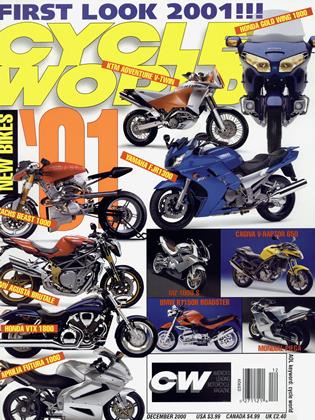SUZUKI Hayabusa
Long-Term Wrap-Up
My old GSX-R1100 doesn’t even come close to the brute acceleration of my new Hayabusa. The ’Bus sure does eai rear tires, though-l’m lucky to get 3000 miles from a stock Bridgestone! -Donald Hopkins Albany, New York
LIVE FAST
THE ASPHALT BETWEEN THE OFFICE and staffers' homes can stop cowering—our long-term 1999 Suzuki GSX1300R Hayabusa, the Great Steamroller, is being mothballed after nearly two years with us.
Too bad, because we’ve had a good time. The 1300’s done many things well, and a few things better than any bike ever in our long-term fleet. Like accelerate. And velocitate. Which is fine, but overall, it has simply performed with the unerring ease that the 160 horsepower and 99.9 foot-pounds of torque hung in its solid chassis allow. Though only two staffers were popped for speeding, there were countless transgressions. It takes some serious self-control not to break the law on a motorcycle that can go 85 mph in first gear and zap a quarter-mile in 9.86 seconds.
It’s those super-far-out capabilities that made the ’Bus so cool to ride at “normal” speeds. Even just putting along, you’re always aware of The Iceberg, the tremendous depth of what lies beneath. Nothing on the road can out-accelerate you. Nice feeling, even if you never use all the urge on hand.
Life wasn’t all tire smoke and smugly superior attitudes, though. Nah, there was terror, too, as we scared ourselves silly with lots of racetrack time. “Arrrggghhh, I’m in waaayyy too deep...!” Stock brakes, great on the street, didn’t like track abuse.
Fade came after a few hard laps and left a mushy lever that could only be unmushed by bleeding.
Sounds like a mostly perfect good time, eh? Well, no, because we had other troubles. Topping the list is the clutch. Ours was bad-very grabby under even moderate load for most of our test. Designed with a slipper mechanism to prevent wheel-hop on deceleration, it also incorporates a squeeze mode under load, which allows easier clutch pull while still enabling the plates to hang onto the mondo torque. Thing is, ours has been apart three times, twice to put in all-new plates and springs, once to replace a few discolored steel plates. The latest, by Barnett ($246), improved feel, but still didn’t cure the trouble. What’s up, Suzuki?
Additionally, recalls to replace a potentially faulty camchain adjuster and clogging fuel screen stopped the ’Bus for a few days. Both procedures were performed free of charge. That was it in terms of OE-parts mechanical problems. The bike was essentially bulletproof otherwise, with no breakdowns and so no repair costs.
I have been very impressed with my Hayabusa’s performance. It minds me of my 1990 Kawasaki ZX-11, except it els much lighter, lias more power and handles beter! Definitely the ultimate sporttouring bike. -Scott Uten Seattle, Washington
As mentioned in our last update, tire-smoking racetrack use-not to mention two flat rear tires (worth $500)-pumped up the maintenance costs considerably. But it did allow us
to sample the bike on three different brands of rubber. The Hayabusa reacted poorly to the Pirelli Dragon Evos ($434) we spooned on most recently. Outright grip was good, but low-speed steering was en-truckened, and the neutral nature provided by the stock Bridgestone BT56Js ($355), as well as the set of Dunlop D207s ($360) we tried, was gone. Stock tires worked best.
Ergonomics received the biggest share of consistent logbook pans. High footpegs, lowish bars and the windblaster horizontal windscreen conspired to discomfort you on the longer haul. And although the supportive seat does its best to allay the negatives, it’s overwhelmed. This is an aggressive sportbike riding position. Stop to stretch, you’ll be fine.
In recent times, low-speed throttle response was berated, and fuel mileage dropped to the low 20s, hurting the overall average considerably. We had installed both a Yoshimura TriOval Duplex stainless-steel exhaust system with titanium canister ($1095)
and a Dynojet Power Commander II fuel-injection kit ($329). At first, rideability improved over stock. As the miles wore on, however, performance deteriorated. Our early production PCII was to blame, a glitch causing it to deliver a too-rich mixture. A new unit was fitted, power is back to normal and response is crisp. response
After all the rapid miles, our Hayabusa proved to be a superior motorcycle and its departure leaves a void in our long-term fleet that will be hard to fill. It’s a difficult act to follow. Particularly on the throttle. O
What does the ’Busa provide? Power, power, power, power! You don’t have to think about what gear you’re in, just turn the throttle, overtake and relax. -Georg Hartl Munich, Germany
$10,499
 View Full Issue
View Full Issue
More From This Issue
-
 Up Front
Up FrontCafé Society
December 2000 By David Edwards -
 Leanings
LeaningsOrthopedic Bike
December 2000 By Peter Egan -
 TDC
TDCPaying the Price
December 2000 By Kevin Cameron -
 Departments
DepartmentsHotshots
December 2000 -
 Roundup
RoundupKawasaki Goes Green
December 2000 By Matthew Miles -
 Roundup
RoundupEnter the Drako?
December 2000 By Brian Catterson





